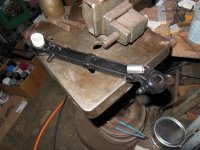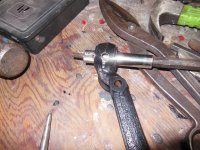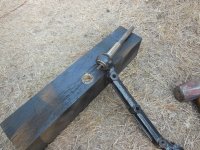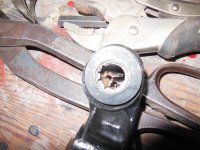The perfect driver would be a steel rod with a step, so the step goes into the bushing and protects it while the larger step drives it in.
Assuming you don't have a driver like that, you will need a steel driver (like the back side of a socket), that you can place on the bushing and makes full contact...then either press to tap into place. The danger is if the bushing gets cocked at an angle, it will wedge and jam, so further tapping will distort and ruin it. Start straight and always keep the driver in full contact, but tap on the side of the driver that is higher as you go. Once the bushing is far enough in that cocking is no longer an issue, then you can tap a bit harder...but never BFH hard!
There is a chance that, without the perfect tool, the edge you tap may develop a burr. So long as the burr is not into the steel shell, you can ream it out afterwards.

 Hey there Guest!
Hey there Guest!
 smilie in place of the real @
smilie in place of the real @
 Pretty Please - add it to our Events forum(s) and add to the calendar! >>
Pretty Please - add it to our Events forum(s) and add to the calendar! >> 







 A friendly reminder - be careful what links you click on here. If a link is posted by someone you don't know, or the URL looks fishy, DON'T CLICK. Spammers sometimes post links that lead to sites that can infect your computer, so be mindful what you click.
A friendly reminder - be careful what links you click on here. If a link is posted by someone you don't know, or the URL looks fishy, DON'T CLICK. Spammers sometimes post links that lead to sites that can infect your computer, so be mindful what you click.